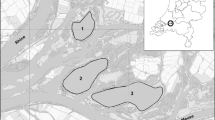Abstract.
The objective of this study was to determine if trace metal bioavailability from suspended particulate matter (SPM) and recently deposited lake sediment (LS) to the filter-feeding bivalve Mytilus trossulus was dependent on the nutritional content and/or the geochemistry of the sediment. For SPM these characteristics are seasonally dependent; for LS they are dependent on lake chemistry and trophic status. To meet this objective, SPM was sampled from the Fraser River estuary, British Columbia, Canada, during Winter (March), spring (April, May), and summer (June, July) months. Deposited LS was sampled from an acidic dystrophic and a circumneutral, oligotrophic lake. Sediments were labeled with 109Cd, fed to M. trossulus and the amount of 109Cd accumulated over a 4-h feeding period assessed. Simultaneous extraction (separation of the sediment into easily reducible, reducible, and organic sediment components) of the radiolabeled sediments indicated that 109Cd associated with the inorganic, not the organic portion of sediment. The amount of 109Cd accumulated by the mussel over the 4-h feeding period was dependent on sediment %carbon (%C) and %nitrogen (%N) content (R2 = 0.75 and 0.52, respectively, for SPM and R2 = 0.76 and 0.64 for LS, respectively), and not on sediment concentrations of easily reducible manganese or reducible iron. These findings suggest that mussels obtain 109Cd from the inorganic portion of sediment as a consequence of digestive processes that are selecting for the carbon and nitrogen component of sediment. Hence, accumulation of cadmium from sediment will be dependent on sediment %C, and to a lesser extent %N content; however, amounts that the organism will be exposed to will depend on concentrations present on the inorganic component. Predictive models of metal accumulation by filter-feeding organisms need to consider the role of both sediment components for predicting amounts of metal that the organisms will bioaccumulate.
Similar content being viewed by others
Author information
Authors and Affiliations
Additional information
Received: 18 June 1998/Accepted: 21 October 1998
Rights and permissions
About this article
Cite this article
Pollet, I., Bendell-Young, L. Uptake of 109Cd from Natural Sediments by the Blue Mussel Mytilus trossulus in Relation to Sediment Nutritional and Geochemical Composition. Arch. Environ. Contam. Toxicol. 36, 288–294 (1999). https://doi.org/10.1007/s002449900473
Issue Date:
DOI: https://doi.org/10.1007/s002449900473




